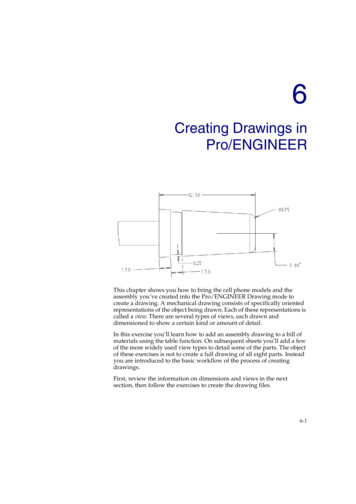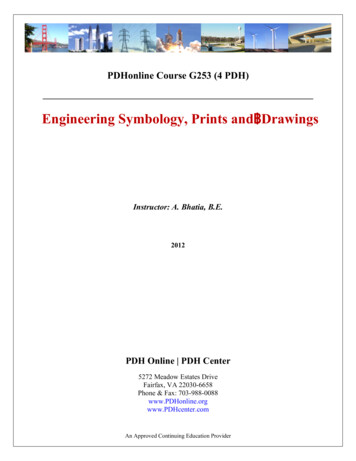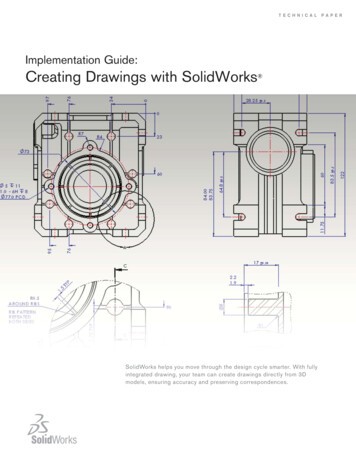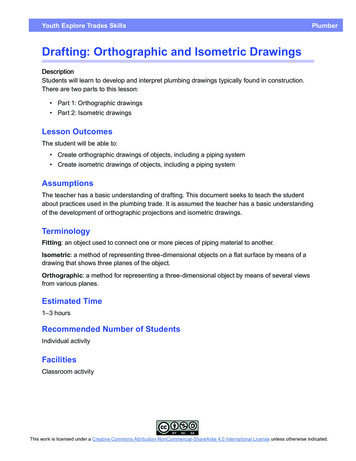![Drawings Of Leonardo Da Vinci [by Charles Lewis Hind]](/img/6/cnm45b2242355.jpg)
Transcription
HANDBOUNDAT THEUNIVERSITY OFTORONTO PRESS
DRAWINGS OFLEONARDO DA VINCIDRAWINGS OF THEGREAT MASTERS
DR/WINGS OFLEONARDO DAVINCILONDON.GEORGE NEWNES LIMITEDSOUTHAMPTON STREET. STRANDw.cNfiW YORK.CHARLES SCRIBNEKS SONS
IMC.\\(f THK BALLANTYNE PKKSSTAVISTOCKST.LONDON
LIST OF ILLUSTRATIONSPLATEPROFILE OF A WARRIORPORTRAIT OF ISABELLA D'ESTE.Frontispiece.iSTUDY OF AN OLD MANSTUDY OF DRAPERIES FOR KNEELING FIGURESSTUDY OF A BACCHUSHEAD OF A MANBATTLE BETWEEN HORSEMEN AND MONSTERSWOMAN SEATED ON GROUND AND CHILDKNEELINGSTUDIES OF HEADSYOUTH ON HORSEBACKSTUDIES FOR THE EQUESTRIAN STATUE OFFRANCESCO SFORZA} THE VIRGIN, ST. ANNE AND INFANTSTUDIES OF CHILDREN.,THE COMBAT.HEADS.inivvvivnvmixxxixiixmSTUDY FOR A MADONNASTUDIES FOR "THE HOLY FAMILY"STUDIES FOR "THE LAST SUPPER"COURTYARD OF A CANNON-FOUNDRYSTUDY OF THE HEAD OF AN APOSTLESTUDY FOR BACKGROUND OF "THE ADORATIONOF THE MAGI"STUDY OF LANDSCAPESTUDY OF A TREETWOnCARICATURESJOHN THE BAPTISTTHE HEAD OF CHRISTST.CARICATURESHEAD OF AN ANGELSTUDY OF A MAN'S HEADxivxvxvi.xvn.xvmxixxxxxixxnxxmxxivxxvxxvixxvn
LIST OF ILLUSTRATIONSSTUDIES OF HANDSDRAGON FIGHTINGMAN KNEELING.WITH A.LIONST.xxxn.xxxniWOMANxxxiv.xxxvANNE CARTOONxxxvixxxvnHEADS OF A WOMAN AND A CHILD.STUDY OF DRAPERY FOR A KNEELING FIGUREKNIGHT IN ARMOURSTUDY OF A YOUTHFUL HEADSTUDY FOR "LEDA"HEAD OF AN OLD MANSTUDY OF A HEADSTUDY OF THE HEAD OF ST. PHILIP FOR "THELAST SUPPER"STUDY OF DRAPERY.HEADSTUDIES OF A SATYRxxixxxxiSTUDIES OF HORSESGIRL'SxxvmxxxPORTRAIT STUDYSTUDIES OF ANIMALSPORTRAIT OF LEONARDO, BY HIMSELFSIX HEADS OF MEN AND A BUST OF ASTUDY OF A IIWITH A LIONXLVIII
THE DRAWINGS OFLEONARDO DA VINCIBYC.LEWIS HINDEONARDO DA VINCI foundin drawing the readiestand most stimulating way of self-expression. Theuse of pen and crayon came to him asnaturally asthe monologue to an eager and egoistic talker.The"outline designs in his " Treatise on Paintingaidand amplify the text with a force that is almostunknown in modern illustrated books. Open the pages at random.Here is a sketch showing " the greatest twist which a man canmake in turning to look at himself behind.'* The accompanyingtext is hardly needed.The drawing supplies all that Leonardowished to convey.Unlike Velasquez, whose authentic drawings are almost negligible, pen, pencil, silver-point, or chalk were rarely absent fromLeonardo's hand, and although, in face of the Monna Lisa and TheVirgin of the ' pcks and the St. Anne it is an exaggeration to say thathe would have been quite as highly esteemed had none of his workexcept the drawings been preserved, it is in the drawings that werealise the extent of " that continent called Leonardo."The inward-smiling women of the pictures, that have given Leonardo aspainter a place apart in the painting hierarchy, appear again andAnd in the domain of sculpture, whereagain in the drawings.Leonardo also triumphed, although nothing modelled by his handnowwe read in Vasari of certain " heads of womenremains,smiling."" Hiswas never at rest," says Antonio Billi, his earliest" his mind was everThe restbiographer,devising new things."lessness of thatprofound and soaring mind is nowhere so evident asin the drawings and in the sketches that illustrate the manuscripts.Nature, in lavishing so many gifts upon him, perhaps withheld concentration, although it might be argued that, like the bee, he didnot leave a flower until all thehoney or nourishment he needed waswithdrawn.He begins a drawing on a sheet of paper, his imagination darts and leaps, and thepaper is soon covered with variousspirit7
THE DRAWINGS OF LEONARDO DAVINCIthe margins of his manuscripts he jotted down" Codex Atlanticus "clauses of theideas.pictorialwe find an early sketch for his lost picture of Leda.The world at large to-day reverences him as a painter, but toLeonardo painting was but a section of the full circle of life.the vision or to the brain of manEverything that offered food toIn the letter that he wrote to the Duke of Milanappealed to him.in 1482, offering his services, he sets forth, in detail, his qualificationsin engineering and military science, in constructing buildings, inwith theconducting water from one place to another, beginning" I can constructandstrongclause,bridges which are very lightand very portable." Not until the end of this long letter does hemention the fine arts, contenting himself with the brief statement," I can further executesculpture in marble, bronze, or clay,designs.UponBetween thealso in painting I canAstronomy,doasmuchasany oneelse,whoever he be."botany, he brought hisundertakes to write uponoptics, physiology, geology,Indeed, he whoupon all.He was militarydazed by the range of his activities.withthe construche occupied himselfengineer to Caesar Borgiahe proposed to raise thetion of hydraulic works in Lombardyhe schemed to connectBaptistery of San Giovanni at Florencehe experimentedthe Loire by an immense canal with the Saonewith flying-machines ; and his early biographers testify to his skillas a musician.Painting and modelling he regarded but as a moietyHe spared no labour over a creation that absorbedof his genius.Matteo Bandello, a member of the convent of Santa Mariahim.della Grazie, gives the following account of his method when" He waswont, as I myself haveengaged upon The Last Supper.often seen, to mount the scaffolding early in the morning and workuntil the approach of night, and in the interest ofpainting he forgotboth meat and drink. There came two, three, or even four dayswhen he did not stir a hand, but spent an hour or two in contemplaI have seenting his work, examining and criticising the figures.atwhenthesunthestoodinofhim, too,noon,Leo, leave thesignCorte Vecchia (in the centre of the town), where he was engagedon his equestrian statue, and go straight to Santa Maria della Grazie,mount the scaffolding, seize a brush, add two or three touches to asingle figure, and return forthwith."Leonardo impressed his contemporaries and touched their imaginations, even as he captivates us to-day. Benvenuto Cellini describesKing Francis as hanging upon Leonardo's words during the last" he did not believethat any otheryears of his life, and saying thatmindto bearLeonardois;;;;o
THE DRAWINGS OF LEONARDO DAVINCIman had comeinto the world who had attained so great a knowledgeLeonardo."Everybody knows Pater's luminously imaginativeonLeonardo, and scientific criticism has said perhaps the lastessayword upon his achievement in Mr. McCurdy's recent volume, andin Mr. Herbert P. Home's edition of Vasari's " Life."As to the" Thedrawings, Mr. Bernhard Berenson, in his costly work onDrawings of the Florentine Masters," has included a catalogueraisonne, has scattered lovely reproductions through the pages, andIn theplaced his favourites on the pinnacle of his chestext,manuscripts,the tremendous sweep of Leonardo's mental activity.Some are mpletepromise"of the MSS. at an early date.His " Treatise on Painting is easily"accessible in Dr. Richter's " Literary Works of Leonardo da Vinci" Thethat wonderful treatise which beginsyoung studentshould, in the first place, acquire a knowledge of perspective, toenable him to give every object its proper dimensionsafter which,it ishethatbeunderofanablethecaremaster, to accustomrequisitehim, by degrees, to a good style of drawing the parts.Next, heshould study Nature, in order to confirm and fix in his mind thereason of those precepts which he has learnt.He must also bestowsome time in viewing the works of various old masters, to form hiseye and judgment, in order that he may be able to put in practiceall that he has beenChapter ccxxx. in the section ontaught."" Colours " is entitled " How topaint a Picture that will Last Almostfor Ever."In view of the present condition of The Last Supper atMilan, fading from sight, Leonardo was wise to insert the word" almost."He is constantly giving the reader surprises, and not the"least of them is the series of " Fablesfrom his pen, included inDr. Richter's edition of his literary works.One authentic portrait of Leonardo by his own hand exists thered chalk drawing in the library at Turin.Dating from the lastofhisofitshowsthefaceamouldedlife,seer,yearsby incessantas::The eyes lurk deepthought into firm, strongly marked lines.beneath shaggy brows, the hair and beard are long and stragglingit is the face of a man who haspeered into hidden things and whohas pondered deeply over what he discerned. The beard is no longer" curled and wellkept," in the words of a contemporary document,wherein he is described as " of a fine person, well proportioned, fullof grace and of a beautiful aspect, wearing a rose-coloured tunic,short to the knee, although long garments were then in use."Mr. Berenson has suggested that the youth in armour, who alone9
THE DRAWINGS OF LEONARDO DAVINCIthe figures in Leonardo's Adoration of the Magi in theLouvre turns away from the scene and looks towards the spectator,Botticelli reproduced his ownis a portrait of Leonardo himself.his Adoration of the Magi.infeatures in a figure similarly placedThe largest collection ot Leonardo da Vinci's drawings is in theare not accessible to theat Windsor Castle.amongallTheyRoyal Librarybut under certain conditions they may be examined.Other collections are in the Louvre, the British Museum, the Uffizi,the Royal Library at Turin, the Venice Academy, and in the portfolios of private collectors such as M. Bonnat of Paris, and Dr. MondThe drawings in the Print Room of the Britishof London.Museum, which are easily available to students, include the remarkable Head of a Warrior in profile, from the Malcolm Collection,which is reproduced in this volume. This beautiful and minutelyfinished head and bust in silver-point belongs to Leonardo's earlyunder the influence of his master, Verrocchio.period, when he was stillbetween this arrogant warrior and theisaresemblancethereIndeed,head of Verrocchio's statue of Colleoni at Venice ; it has beenan effort of thesuggested by Dr. Gronau that this profile representsin which he would have handledmannertheshowVerrocchiotopupilBe that as it may, this drawing is a striking example ofthe task.thehands of a master, the most profuse and detailed decorainhow,The eye followstion can be made subservient to the main theme.with delight the exquisite imaginative drawing in armour and helm.public in general,Nothingisinsistentcurious detail leadsEvery quaint andup to the firm contour of the face. Leonardoa whole, and the decorator's ingenuity has;nothingissuperfluous.saw the theme asIt is Warthroughout remained subservient to the artist's vision.The Britishquiescent, as Rodin's famous group is War militant.Museumof those grotesque heads, specimens ofthis volume, horrible faces of men andwomen grimacing and screeching at one another, with protrudingIn alips and beak-like chins, looming from the discoloured paper.drawing at Milan there are two sketches of a combat, a man onhorseback fighting a grotesque animal, that are startling in theirThere are also drawings of fearfulpower of arrested movement.wild-fowl, dragons, and the like, snarling at one another and makingCritics have tried to explain the reason whyfrightful onslaught.Leonardo gazed into these gulfs, but the explanation is probablynothing more than the fertility and fecundity of his imagination.The grotesque and the terrible often have an attraction for giftedminds, forming a relief from the endless quest after beauty and the10whichalso contains a sheetare reproduced in
THE DRAWINGS OF LEONARDO DAVINCIRossetti comphysical strain of living continually on the s.distinposedguished living writer has confessed that the byways of his leisureare brightenedby the study of criminology. The late Arthur Strong,onthe grotesques by Leonardo da Vinci at Chatsworth,commenting" His method wascontributes this curious and interesting theoryakin to the geometry of projection.Just as the shadow of a circleA:ellipse, so by projecting the lines of a human face of a certainmarked type he was enabled to detect and exhibit, as in a shadow,the secret but most real kinship between the bete humaine and theisanIn a sheet ofdog, the ape, or the swine, as the case might be.atWindsorweseethesametothe head ofdrawingsprocess applieda lion until it quickens into a lower canine form."The late librarian of Chatsworth also comments upon the copiesand forgeries of drawings by Leonardo da Vinci that abound atThe process of sifting theChatsworth, as in other collections.ascribedtoLeonardobesaid to be complete.picturesJohnmayWilliam Brown, in the Appendix to his life of Leonardo, publishedin 1828,catalogues nearly fifty pictures from the hand of the master.Mr. McCurdy, in his study of the records of Leonardo's life, hasreduced that generous estimate to ten. There is still considerabledisagreement about some of the drawings, but there are enoughindubitably authentic, a bewildering variety indeed, for all practicalpurposes of study, and to proclaim the abounding genius of thisflame-like Florentine, whose mind was a universe and who " painted"little but drew muchwith " that wonderful left hand." The factthat Leonardo was left-handed, with the result that the shading ofhis drawings usually runs from left to right, and not from right toleft, should be evidence, as Morelli and others have pointed out, ofthe authenticity of those drawings whose lines of direction run fromleft toBut this test is far from perfect, as it is the firstright.business of a forger to study mannerisms.Many of the drawingsbear comments in his handwriting, which also usually ran from rightto left, the famous letter to the Duke of Milan being an exception.pen-drawing in the Uffizi has, in the lower part, a note fromAwhich the beginning has been torn away. The
dr/wingsof leonardoda vinci london.georgenewneslimited southamptonstreet.strandw.c nfiwyork.charlesscribnekssons











